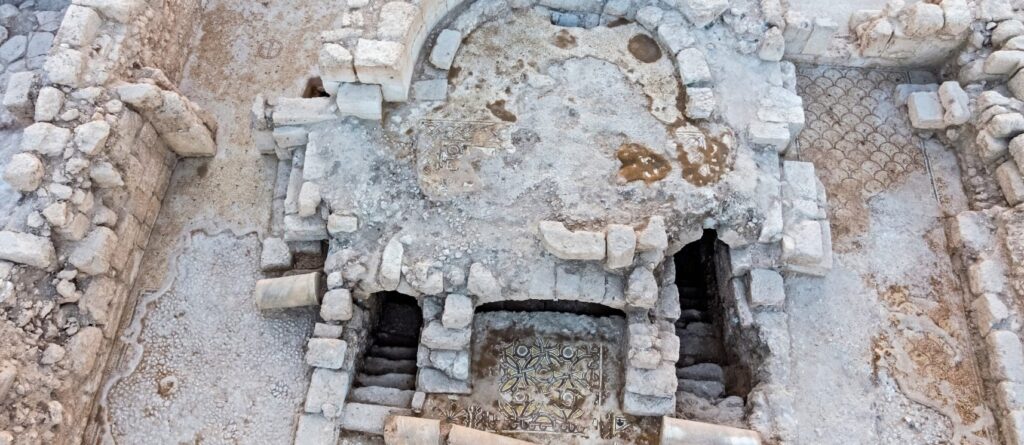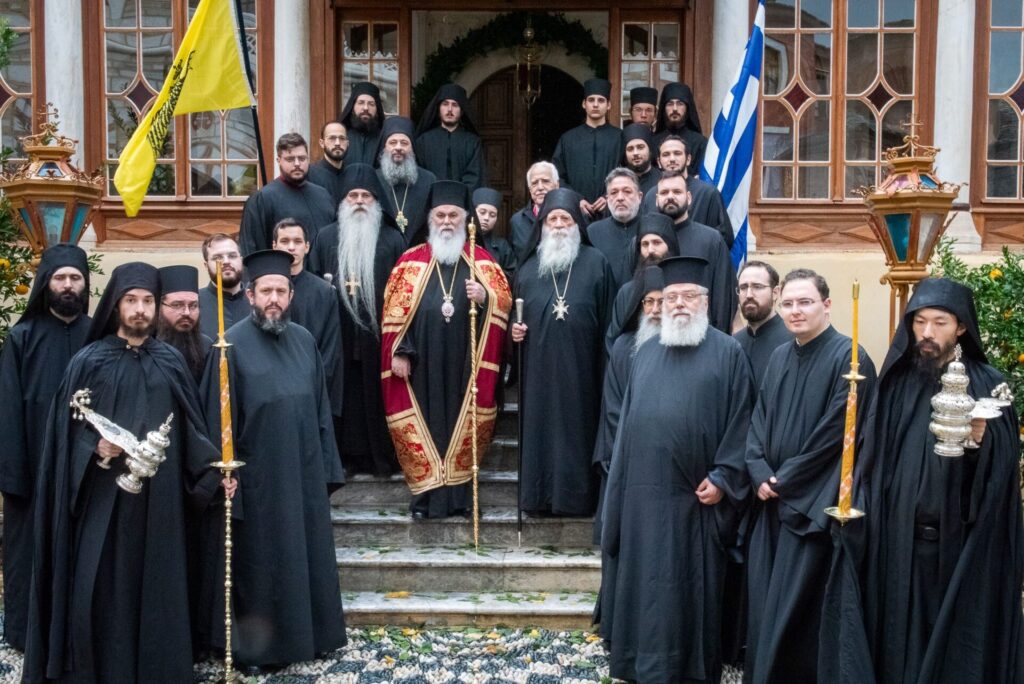Ancient Church Dedicated to Mysterious Martyr Found Near Jerusalem

Israeli archaeologists uncover stunning mosaics and glass windows but remain stumped by identity of the ‘glorious martyr’ to whom the 6th-century basilica was dedicated
Israeli archaeologists have uncovered a Byzantine basilica built under the Emperor Justinian and decorated with stunning mosaics and glass windows, as well as an inscription that dedicates the church to an unnamed “glorious martyr.” Who that was however remains a mystery.
The 6th-century shrine was discovered ahead of building a new neighborhood in the town of Beit Shemesh, west of Jerusalem. It has been undergoing salvage excavation by the Israel Antiquities Authority for three years, archaeologists said at an unveiling of the site on Wednesday.
The church remained a popular pilgrimage destination through the early Islamic period. That in and of itself contributed to a longstanding debate among scholars about how violent and sudden the Muslim conquest of the Holy Land was, and the subsequent conversion of the population.
Built according to the typical basilica plan, with a central nave flanked by two halls, the church was adorned with intricate mosaics depicting plants, birds, and geometrical designs, as well as colorful frescoes that lined the walls.
The religious complex sprawled over 1.5 dunams (1,500 square meters) and sported several additional spaces connected to the main building, including a large courtyard in front of the church’s entrance.
“Both the basilica and the courtyard are massive for the period – larger than most Byzantine churches found in the Holy Land,” says Benjamin Storchan, dig director for the IAA.
It was in the courtyard that researchers uncovered an intact Greek inscription dedicating the sacred site to the memory of an “endoxo martis” – a glorious martyr.
“The martyr’s identity is not known, but the exceptional opulence of the structure and its inscriptions indicate that this person was an important figure,” says Storchan.
Somebody named Malchos
Scholars are turning to ancient sources – mainly pilgrimage accounts and lists of early Christian martyrs – to try to identify this holy personality, but so far they have been unable to pinpoint it.
What we do know is that the location of the church, in a valley outside the Byzantine rural town of Beit Nativ, must have somehow been linked to the martyr’s life.
“It’s doesn’t make sense to build such a monumental structure at the bottom of a valley, unless it marks the place of the death or the subsequent burial of the martyr,” Storchan says.
The text in the courtyard does say that the church was completed in 542 C.E. and names the main benefactor and abbot of the monastery as someone called Malchos. Since this is a common Semitic name, which appears numerous times in various sources, it is hard to identify him further, the archaeologist says.
Inside the basilica, archaeologists were able to access the crypt that may have once housed the relics of the unnamed holy person, displayed in the underground chamber for veneration by the faithful.
“Only a few churches in Israel have been discovered with fully intact crypts,” Storchan says. “The crypt was accessed via parallel staircases – one leading down into the chamber, the other leading back up into the prayer hall. This enabled large groups of Christian pilgrims to visit the place.”
The crypt was initially decorated with lavish marble panels. These were removed in a later phase and the vaulted space was covered in plaster, on which some pilgrims have left graffiti in Arabic script and the image of a fish – a typical early Christian symbol. Experts are still working to decipher the text.
Imperial eagle
Initially erected during Justinian’s reign (527-565 C.E.), the church was further enlarged through money donated by the Emperor Tiberius II Constantine, who ruled from 574 to 582 C.E.
Constantine’s personal involvement in the project is attested by another Greek inscription found in a large annex chapel and dated to 583 C.E. – a year after Tiberius’ death. The chapel was likely meant to memorialize the recently deceased ruler, who is evoked by a large imperial eagle with outspread wings which appears in the mosaic at the center of the chapel.
“Numerous written sources attest to imperial funding for churches in Israel, however, little is known from archaeological evidence such as dedicatory inscriptions like the one found in Beit Shemesh,” says Storchan.
After the Muslim conquest of the Holy Land in the first half of the 7th century the complex continued to be used and the martyr worshipped, as attested by some 300 clay lamps from the early Islamic period that were found in the crypt.
“A number of excavations over the last 20 years have shown that the theory of a conquest by sword is being washed away,” Storchan says. “Islamic sources may have exaggerated how quick and violent the conversion was.”
Among the thousands of objects unearthed was what may be the most complete collection of Byzantine glass windows and lamps ever found at a single site in Israel, the IAA stated. The archaeologists also found a unique baptismal font in the shape of a cross that was made with calcite stone mined from a stalactite cave.
Most of the work at the site was done by thousands of teenagers from all over the country who participated in the dig as part of an IAA program to connect Israeli youths to their heritage, the statement said.
“It started as a summer job, but after the first year I couldn’t stop and I came back as a volunteer, both here and at other sites,” says Netanel Romm, a local resident who first came to work at the church when he was 16.
Romm, who is a religious student at a yeshiva, says the project helped him learn more about Christianity and its history in the Holy Land. “Digging in a church doesn’t bother me at all. On the contrary, I didn’t know much about Christian culture before, so it is interesting for me to learn about it and about what happened during history in my own backyard,” he says.
Israel’s Ministry of Construction and Housing invested around 7 million shekels ($2 million) in the dig, and a total of 70 million shekels ($20 million) in excavating and documenting the archeological finds in the planned neighborhood.
The main finds from what has now been dubbed the Church of the Glorious Martyr will be the focus of an exhibition opening Wednesday evening at the Bible Lands Museum in Jerusalem. The show is set to run until April.
As for the site itself, the area of the church was not slated to house buildings for the new neighborhood, just some water pipes that now been rerouted, Storchan says. This means the basilica will be preserved, he says: experts are presently discussing how best to protect it and make it accessible to the public.
- Source: haaretz.com
H αναδημοσίευση του παραπάνω άρθρου ή μέρους του επιτρέπεται μόνο αν αναφέρεται ως πηγή το ORTHODOXIANEWSAGENCY.GR με ενεργό σύνδεσμο στην εν λόγω καταχώρηση.
Ακολούθησε το ORTHODOXIANEWSAGENCY.gr στο Google News και μάθε πρώτος όλες τις ειδήσεις.


















